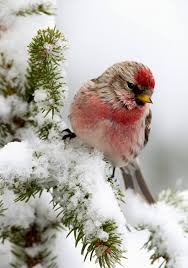
Thursday
Although our first snowfall of the season delivered only a couple of inches, our bird feeders are being assaulted by hoards of chickadees, tufted titmice, nuthatches, cardinals, Carolina wrens, purple finches, goldfinches, yellow bellied sapsuckers and downy, hairy, and red-headed woodpeckers.
I think of the passage from Sir Gawain and the Green Knight where Gawain is at the end of the rope as he searches for the “Green Chapel,” the site of his rendezvous with the Green Knight. While we aren’t given a direct insight into how he’s feeling—as a Camelot knight, he’s not supposed to have doubts—we get a pretty good sense from the surrounding description. Alone and depressed, Gawain can identify with the birds “upon bare twigs that peeped most piteously for pain of the cold”:
By a mountain next morning he makes his way
Into a forest fastness fearsome and wild;
High hills on either hand, with hoar woods below,
Oaks old and huge by the hundred together.
The hazel and the hawthorn were all intertwined
With rough raveled moss, that raggedly hung,
With many birds unblithe upon bare twigs
That peeped most piteously for pain of the cold . . .
Here’s a poem by the Victorian poet Oliver Herford with a different take. The very fact that we hear birdsong at this time of year reminds us that the cold will not last forever.
I heard a bird sing In the dark of December. A magical thing And sweet to remember. "We are nearer to Spring Than we were in September,” I heard a bird sing In the dark of December.
Incidentally, ornithologists don’t know why birds sing in the winter since mating season is months away. Some think it is to stay in practice, others (although this would only be true after December 21) that that they are responding to increasing day length. This latter theory, which I owe to National Geographic and the Lyric Wild Bird Food website, accords nicely with Herford’s poem:
Since these winter songbirds evolved to survive in harsh winter conditions, it makes sense that their brains are attuned to the changes in seasonal light. This increasing amount of light may trigger something in the brain that the time is coming to start thinking about spring territories.